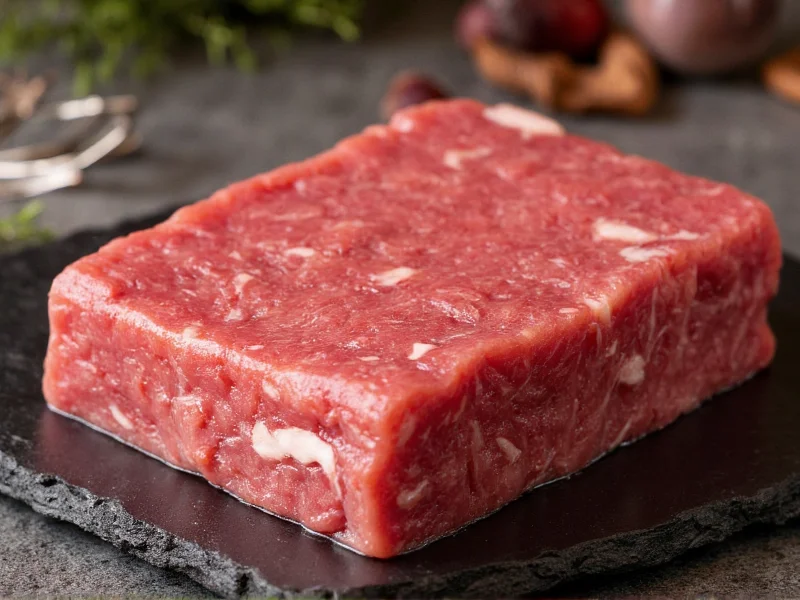Originating in Scotland during the late 19th century, lorne sausage has become an iconic element of Scottish culinary tradition. Unlike conventional sausages that come in cylindrical casings, lorne sausage's unique square shape makes it instantly recognizable and practical for slicing and cooking. The name "lorne" reportedly comes from the Marquess of Lorne, though some food historians debate this origin.
What Sets Lorne Sausage Apart
The distinctive characteristics of lorne sausage differentiate it from other breakfast meats. Its square form factor isn't just for appearance—it serves practical cooking purposes. When placed in a frying pan, the flat surface creates an ideal crispy exterior while maintaining a tender interior. Traditional lorne sausage contains a higher proportion of rusk (dried, minced bread) compared to regular sausages, giving it a unique texture that holds together well during cooking without casing.
| Feature | Lorne Sausage | Traditional Sausage |
|---|---|---|
| Shape | Square/rectangular block | Cylindrical |
| Casing | No casing | Natural or synthetic casing |
| Rusk Content | Higher percentage | Lower percentage |
| Cooking Method | Sliced and pan-fried | Whole or sliced, various methods |
Traditional Ingredients and Preparation
The authentic lorne sausage recipe maintains a simple ingredient profile that highlights Scottish culinary traditions. Butchers typically use coarsely minced pork shoulder (sometimes with beef), combined with rusk, salt, pepper, and a blend of spices that often includes nutmeg, mace, and coriander. Some regional variations incorporate onions or other seasonings.
The preparation process involves thoroughly mixing the ingredients, then pressing the mixture into rectangular molds. After chilling to firm up, the block is sliced into portions approximately 1/2 inch thick before cooking. This square sausage cooking technique ensures even browning and the characteristic crispy edges that Scottish breakfast enthusiasts prize.
Cultural Significance in Scottish Cuisine
Lorne sausage holds a special place in Scotland's food heritage, particularly as part of the traditional Scottish breakfast—often called a "full Scots". This hearty morning meal typically includes lorne sausage alongside other components like:
- Link sausages
- Bacon
- Black pudding
- Haggis
- Fried eggs
- Tattie scones (potato cakes)
- Baked beans
- Mushrooms and tomatoes
The inclusion of square sausage in this substantial breakfast reflects Scotland's historical need for calorie-dense morning meals to sustain workers through long days in demanding occupations like fishing, farming, and mining.
Modern Availability and Variations
While traditionally a Scottish specialty, lorne sausage has gained recognition beyond Scotland's borders. Many specialty butchers worldwide now offer authentic Scottish square sausage, and several food manufacturers produce versions for supermarket distribution. Some contemporary variations include:
- Veggie lorne sausage made with plant-based proteins
- Gluten-free versions using alternative binders
- Spicy variations with added chili peppers
- Organic and free-range meat options
When seeking authentic lorne sausage outside Scotland, look for products labeled "Scottish square sausage" or "breakfast square" at specialty food stores or online retailers that specialize in British foods. For those interested in homemade preparation, traditional Scottish square sausage recipes typically call for specific ratios of meat to rusk to achieve the proper texture.
Cooking Tips for Perfect Lorne Sausage
Achieving the ideal texture and flavor when preparing lorne sausage requires attention to cooking technique. Unlike regular sausages that can be grilled or baked, square sausage benefits from pan-frying:
- Chill the sausage block before slicing for cleaner cuts
- Cut slices approximately 1/2 inch thick
- Use medium heat in a well-seasoned cast iron or non-stick pan
- Avoid overcrowding the pan to ensure proper browning
- Cook for 3-4 minutes per side until golden brown and heated through
- Drain on paper towels to remove excess grease
The perfect lorne sausage slice should have a crispy exterior with a tender, slightly springy interior. Overcooking can cause the sausage to become dry and crumbly, while undercooking leaves it too soft to hold its shape.
Frequently Asked Questions
What is lorne sausage made of?
Traditional lorne sausage consists of coarsely minced pork (sometimes with beef), rusk (dried bread crumbs), salt, pepper, and a blend of spices including nutmeg, mace, and coriander. The mixture is pressed into a rectangular block without casing, distinguishing it from conventional sausages.
Why is it called square sausage?
Lorne sausage earns the "square sausage" nickname from its distinctive rectangular shape. Unlike traditional sausages that come in cylindrical casings, lorne sausage is formed into a solid block, then sliced into square or rectangular portions before cooking. This shape provides maximum surface area for crisping when pan-fried.
How is lorne sausage traditionally cooked?
Traditional preparation involves slicing the chilled lorne sausage block into 1/2 inch thick portions, then pan-frying in a lightly oiled skillet over medium heat for 3-4 minutes per side. The goal is to achieve a golden brown, crispy exterior while maintaining a tender interior. Unlike regular sausages, lorne sausage should never be boiled or steamed, as this would compromise its distinctive texture.
Is lorne sausage the same as black pudding?
No, lorne sausage and black pudding are distinct Scottish breakfast items. Lorne sausage is a square-shaped minced meat product made primarily from pork and rusk, while black pudding is a blood sausage made from pork blood, fat, oatmeal, and seasonings. Both are components of a traditional Scottish breakfast but have different ingredients, preparation methods, and textures.
Can I make lorne sausage at home?
Yes, you can make lorne sausage at home using a traditional Scottish square sausage recipe. You'll need minced pork, rusk, spices, and a rectangular mold (a loaf pan works well). Mix ingredients thoroughly, press into the mold, chill until firm, then slice and cook. Homemade versions allow customization of spice levels and meat-to-rusk ratios to suit personal preferences while maintaining the authentic square sausage characteristics.











 浙公网安备
33010002000092号
浙公网安备
33010002000092号 浙B2-20120091-4
浙B2-20120091-4